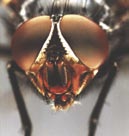
One of the main missions xof the KITP is to catalyze and to promote collaborations, the hallmark of 21-century science. Programs are designed to stimulate new collaborations, but also to reinvigorate old ones between collaborators once in close proximity, but now separated geographically. Such is the case with two participants in the 2004 “Brain” workshop: physicists William Bialek of Princeton and Rob de Ruyter van Steveninck of Indiana University. The former is a theorist; the latter, an experimentalist.
Fresh from his PhD program in biophysics at Berkeley, Bialek headed to Holland in 1983 for a one-year postdoctoral position at Groningen. There he met and worked with de Ruyter, a graduate student at the time. After another postdoctoral position at the KITP and a stint as an assistant professor of physics and biophysics at Berkeley, Bialek worked for 10 years at the research laboratory in Princeton of the large Japanese electronics company NEC. Shortly after Bialek’s arrival, Steveninck joined the NEC team. And their initial relationship, begun in Holland, blossomed into a 10-year collaboration, remarkable for the close interaction between theory and experiment.
“It was,” said Bialek, “a fantastic arrangement. My office and Rob’s office were next door to each other, and his lab was across from my office. The postdocs and students who worked with each of us were all located in the same area. That arrangement meant daily interactions between theory and experiment. Theory influenced not just the analysis and interpretation of experiment, but the nitty-gritty of experimental design. Conversely, there was the now rare opportunity for raw data to impact theoretical thinking.”
What especially appeals to Bialek about working on a biological problem is “the relatively quick turn-around in experiment. Rob could do interesting experiments that could be accomplished in a year, but which addressed real conceptual challenges. Not too many things that physicists are thinking about today have that property because the mainstream fields of physics have matured to the extent that there is now a much greater lead-time in the dynamical interactions of theory and experiment.”
Such close interplay between theory and experiment is particularly good as a training ground for students and postdocs, said Bialek. “Even by the time I was a student in the early ‘80s, many theoretical questions had been purified away from phenomenological beginnings. It is enormously exciting to look with fresh eyes at phenomena in biology that physicists haven’t been climbing all over, and ask when confronted by data, 'What is the question? What moves me? What am I, as a physicist, curious about?'”
How do flies steer?
Bialek and de Ruyter collaborated on exploring the way in which the fly takes its visual input and computes how fast it’s moving, relative to the world, and how it encodes the answer in the spike trains of its neurons. In a long series of theory - experiment projects, they were able to illustrate how this system reaches optimal performance both in the problem of estimating, and in the problem of coding, as well as the role that adaptation, understood as real-time (rather than evolutionary-time), optimization plays both for computing and representing the answer. The simple form of the question they were asking is how do flies steer.
The pair used, in Bialek’s words, “the fly’s visual system and, in particular, the little corner of the fly’s brain that extracts information about motion as a testing ground for ideas about optimization. The fly is almost as reliable as it can be in estimating motion given that its view of the world is blurred by diffraction through the lenses of the compound eye, and through the random arrival of photons at its retina. And the fly seems to be optimized in its representation of the answer — its strategy for encoding the results of its computations in the spikes of its neurons. The beauty of these experiments,” said Bialek, “is that you can see changes in computation and coding strategy on the laboratory time-scale of seconds (in contrast to the evolutionary time-scale of years or millennia). Those results opened up the possibility of testing the ideas of optimization much more deeply.”
Bialek explains, “If optimization happens only over evolutionary time, then it happened once. If we do not understand all the constraints on optimization, the resultant theory may not be adequate. On the other hand, if we can observe the dynamics of optimization, we have a much bigger playground for testing ideas about optimization in terms of the statistical structure of the world in which we live.”
Many people, said Bialek, have pursued the idea that the nervous system and brain are optimal. “I would say that we deserve some share of credit for revitalizing that idea, but we are not the only ones."
Find simplest first
“If optimization were true only in one system, it wouldn’t be a very interesting idea,” he said. “In order for the ideas associated with optimization to gain any credibility at all, it’s vital that lots of people work on them. It’s nice to work on flies, but it’s eminently clear to me that we as humans cannot be intrinsically interested in the fly brain per se, but as an accessible example of some more general principle. The physicist’s style is to find the simplest example first and to understand what’s going on.”
“From the perspective of our current understanding of neuroscience, the idea that the same principles are applicable to very different nervous systems really would be a discovery — seeing, that is, the principles in the second and third instances sufficiently apart on an evolutionary tree to enable us to say, ‘Yes, this principle happens in other systems.’ There may be a time when it will be obvious that these principles are supposed to be universal, but we’re not there yet. At the moment, all ideas have multiple sources because the discoveries of their applicability in different systems are really discoveries.”
